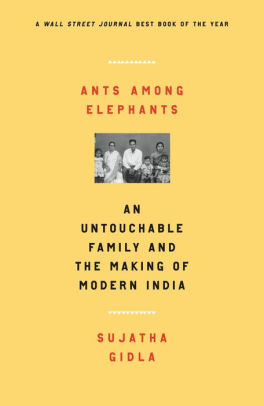by TARIQ ALI
 IMAGE/Barnes & Noble
IMAGE/Barnes & Noble
Ants among Elephants: An Untouchable Family and the Making of Modern India by Sujatha Gidla (Daunt, 341 pp
This is a family biography that encompasses a history rarely told: despite its longevity, caste, and caste oppression, is not a popular theme in India. Sujatha Gidla writes of poisoned lives, of disillusionment, betrayed hopes, unrequited loves, attempted escapes through alcohol and sex. What distinguishes her book is its rich mix of sociology, anthropology, history, literature and politics.
Gidla’s great-grandparents were born in the late 19th century in the Khammam district of what is now Andhra Pradesh. They belonged to a clan of pre-agricultural, forest-based tribal nomads. Hunting and gathering supplied basic necessities; they worshipped their own forest gods. When the occupying British cut down forests and replaced them with teak plantations, the clan was forced out. They found a large lake with no villages nearby and settled on its shores. The soil was rich. They took to agriculture and produced much more rice than they needed. They found a market for the surplus, which meant that they caught the attention of local landlords and their agents: they were forced to pay taxes and dragged into the caste-based Hindu world. As landless agricultural labourers they were the lowest of the low, classed as untouchables, ‘outcastes’. They carried on as normal, until one day they provided shelter, as was their custom, to a fugitive from the Yanadi clan who was on the run from the police. (He was a burglar: the Yanadis rejected all private property rights and it was their ‘sacred duty’ to violate them.) When a few policemen arrived the villagers drove them away. But then Gidla’s clan encountered modernity in the shape of a hundred baton-carrying colonial policemen, who destroyed their goods and food, harassed the women and took every male into custody. ‘The villagers did not know what to do,’ Gidla writes.
They did not know about jails, bail, courts or lawyers. By luck, some Canadian missionaries active in a nearby town learned what had happened. They sent a white lawyer to defend the villagers and win their release. In gratitude, the villagers started to give up their old goddesses and accept baptism. They began sending their children to attend the schools set up by missionaries.
Untouchables had long been forbidden from learning to read or write. But when the missionaries arrived, they opened schools that, to the horror of the Hindus, welcomed even the untouchables … caste Hindus often refused to send their children, unwilling to let them sit side by side with untouchable students.
The stigma extended to animals. Gidla’s uncle K.G. Satyamurthy, later one of the founders of the Maoist People’s War Group, was startled at the age of ten to discover that ‘untouchable buffaloes were not allowed to graze in the same meadows as the caste buffaloes.’
Gidla’s maternal grandparents, Prasanna Rao and Maryamma, lived after their marriage in a village called Adavi Kolanu, where they taught in a mission school. But they moved to the city after Maryamma was insulted by some local upper-caste men who had seen her wearing a new sari the missionaries had bought her as a Christmas present. The two groups – untouchables and caste Hindus – had gathered in the village square when a brahmin intervened:
‘Kill me first before you kill each other,’ he challenged them. To kill a brahmin is the sin of sins. First the untouchables backed down, then the caste Hindus.
London Review of Books for more
